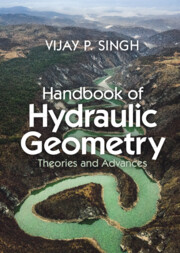Book contents
- Handbook of Hydraulic Geometry
- Handbook of Hydraulic Geometry
- Copyright page
- Dedication
- Contents
- Preface
- Acknowledgments
- 1 Introduction
- 2 Governing Equations
- 3 Regime Theory
- 4 Leopold–Maddock (LM) Theory
- 5 Theory of Minimum Variance
- 6 Dimensional Principles
- 7 Hydrodynamic Theory
- 8 Scaling Theory
- 9 Tractive Force Theory
- 10 Thermodynamic Theory
- 11 Similarity Principle
- 12 Channel Mobility Theory
- 13 Maximum Sediment Discharge and Froude Number Hypothesis
- 14 Principle of Minimum Froude Number
- 15 Hypothesis of Maximum Friction Factor
- 16 Maximum Flow Efficiency Hypothesis
- 17 Principle of Least Action
- 18 Theory of Minimum Energy Dissipation Rate
- 19 Entropy Theory
- 20 Minimum Energy Dissipation and Maximum Entropy Theory
- 21 Theory of Stream Power
- 22 Regional Hydraulic Geometry
- Index
- References
3 - Regime Theory
Published online by Cambridge University Press: 24 November 2022
- Handbook of Hydraulic Geometry
- Handbook of Hydraulic Geometry
- Copyright page
- Dedication
- Contents
- Preface
- Acknowledgments
- 1 Introduction
- 2 Governing Equations
- 3 Regime Theory
- 4 Leopold–Maddock (LM) Theory
- 5 Theory of Minimum Variance
- 6 Dimensional Principles
- 7 Hydrodynamic Theory
- 8 Scaling Theory
- 9 Tractive Force Theory
- 10 Thermodynamic Theory
- 11 Similarity Principle
- 12 Channel Mobility Theory
- 13 Maximum Sediment Discharge and Froude Number Hypothesis
- 14 Principle of Minimum Froude Number
- 15 Hypothesis of Maximum Friction Factor
- 16 Maximum Flow Efficiency Hypothesis
- 17 Principle of Least Action
- 18 Theory of Minimum Energy Dissipation Rate
- 19 Entropy Theory
- 20 Minimum Energy Dissipation and Maximum Entropy Theory
- 21 Theory of Stream Power
- 22 Regional Hydraulic Geometry
- Index
- References
Summary
The interrelationship between flow, sediment transport, channel resistance, and bank stability determines the regime of a channel in alluvium, meaning channel shape and stability. Thus, the regime theory predicts the size, shape, and slope of a stable alluvial channel under given conditions. This chapter presents regime relations for channel width, depth, and gradient.
- Type
- Chapter
- Information
- Handbook of Hydraulic GeometryTheories and Advances, pp. 65 - 109Publisher: Cambridge University PressPrint publication year: 2022

